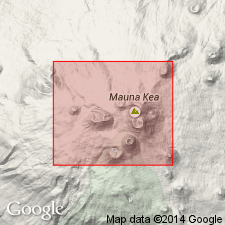
- Usage in publication:
-
- Pohakuloa Drift
- Modifications:
-
- First used
- AAPG geologic province:
-
- Hawaii
Summary:
Name drawn from locality on or near summit area of Mauna Kea Volcano, Island of Hawaii. Consists dominantly of boulder beds. Matrices partly tuffaceous, indicating contemporaneous volcanism.
Source: GNU records (USGS DDS-6; Menlo GNULEX).
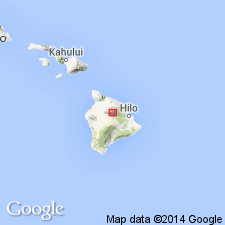
- Usage in publication:
-
- Pohakuloa drift
- Modifications:
-
- Named
- Dominant lithology:
-
- Drift
- AAPG geologic province:
-
- Hawaii
Summary:
[Named] for occurrence on walls of Pohakuloa Gulch where about 50 ft exposed in typical section at rim at 9620 ft elev., S slope of Mauna Kea Volcano, Island of Hawaii. 100 ft exposed in gulch .8 mi W of Waikahalulu at approx 9725 ft elev. Composed of mauve to gray bouldery till. Underlies Waihu drift (new) and overlies pre-Pohakuloa drift. Tentatively correlated with Kansas glacial stage in North America and Mindel stage in Europe. Assigned Pleistocene age.
Source: GNU records (USGS DDS-6; Menlo GNULEX).
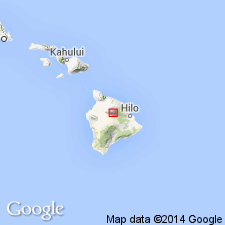
- Usage in publication:
-
- Pohakuloa drift
- Modifications:
-
- Revised
- AAPG geologic province:
-
- Hawaii
Summary:
Pohakuloa "drift" and pre-Pohakuloa "drift" of Wentworth and Powers (1941) redefined as explosion deposits due to lack of striations on blocks, erratics, smooth surfaces ... typical of glacial deposits. "All older so-called drift deposits are definitely explosion deposits, possibly hydromagmatic, due to hot lava breaking through the icecap, but they are not indicative of early glaciations."
Source: GNU records (USGS DDS-6; Menlo GNULEX).
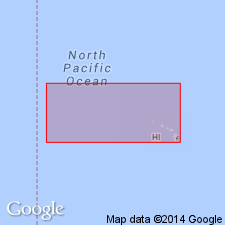
- Usage in publication:
-
- Pohakuloa drift
- AAPG geologic province:
-
- Hawaii
Summary:
Type locality: walls of Pohakuloa Gulch between 8750 and 9500 ft altitude [19 deg 45'28"N, 155 deg 31'30"W, Ahuma 7.5' quad]
Source: GNU records (USGS DDS-6; Menlo GNULEX).
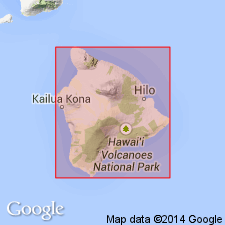
- Usage in publication:
-
- Pohakuloa Formation
- Modifications:
-
- Redescribed
- AAPG geologic province:
-
- Hawaii
Summary:
Pohakuloa Drift redefined as Pohakuloa Formation, upper unit of Hamakua Group. Characterized as oldest exposed glacial drift on Mauna Kea Volcano. Overlies Hopukani Formation (new) of Hamakua Group. Underlies Liloe Formation (new) of Laupahoehoe Group.
Source: GNU records (USGS DDS-6; Menlo GNULEX).
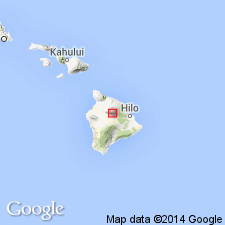
- Usage in publication:
-
- Pohakuloa Formation
- Modifications:
-
- Geochronologic dating
- AAPG geologic province:
-
- Hawaii
Summary:
Unit includes both diamicton and fluvial facies interpreted as till and outwash respectively. Inferred age is between 270,000 and 188,000 yr B.P. based on ages of enclosing formations.
Source: GNU records (USGS DDS-6; Menlo GNULEX).
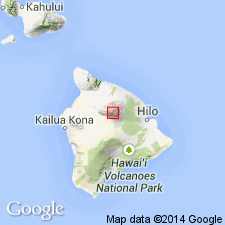
- Usage in publication:
-
- Pohakuloa Formation
- Modifications:
-
- Revised
- Overview
- Reference
- AAPG geologic province:
-
- Hawaii
Summary:
Pohakuloa Formation is herein designated as part of Hamakua Group (formerly Hamakua Volcanic Series). Sediments referred to as Pohakuloa drift and pre-Pohakuloa drift by Wentworth and Powers (1941) and reinterpreted as volcanic explosion breccias (Stearns, 1945; Stearns and Macdonald, 1946) are here included in Pohakuloa Formation. Study showed unit has few features in common with known explosion breccias and in nearly all respects closely resembles younger drifts of Mauna Kea. Reference section on W wall of Waikahalulu Gulch at 3,050 m elev. [19 deg 47' 00"N, 155 deg 30' 31"W, Ahuma 7.5' quad]. Further reference locality where gulch reaches 2910 m elev. Overlies uppermost rocks of Hopukani Formation of Hamakua Group; underlies Waikahalulu Formation of Laupahoehoe Group.
Source: GNU records (USGS DDS-6; Menlo GNULEX).

- Usage in publication:
-
- Pohakuloa Glacial Member*
- Modifications:
-
- Revised
- AAPG geologic province:
-
- Hawaii
Summary:
Pohakuloa Formation reduced in rank and renamed Pohakuloa Glacier Member of Hamakua Volcanics to designate lithology. Is youngest member of Hamakua Volcanics. Exposed mainly in Pohakuloa and Waikahalulu Gulches. Maximum thickness about 40 m. Locally overlies Hopukani Volcanic Member. Is Pleistocene age.
Source: GNU records (USGS DDS-6; Menlo GNULEX).
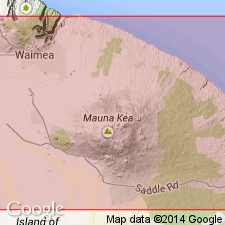
- Usage in publication:
-
- Pohakuloa Glacial Member*
- Modifications:
-
- Geochronologic dating
- AAPG geologic province:
-
- Hawaii
Summary:
Age is bracketed between basalt of underlying Hopukani Springs Volcanic Member (new) (Hamakua Volcanics), with K-Ar age of approximately 150 ka, and several younger flows of overlying Liloe Spring Volcanic Member (new) (Hamakua Volcanics), with limit of about 115 ka. Thus age implied is between 150 and 115 ka. [Unit shown on geologic map of Mauna Kea volcano.]
Source: GNU records (USGS DDS-6; Menlo GNULEX).
For more information, please contact Nancy Stamm, Geologic Names Committee Secretary.
Asterisk (*) indicates published by U.S. Geological Survey authors.
"No current usage" (†) implies that a name has been abandoned or has fallen into disuse. Former usage and, if known, replacement name given in parentheses ( ).
Slash (/) indicates name conflicts with nomenclatural guidelines (CSN, 1933; ACSN, 1961, 1970; NACSN, 1983, 2005, 2021). May be explained within brackets ([ ]).

